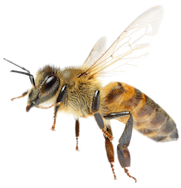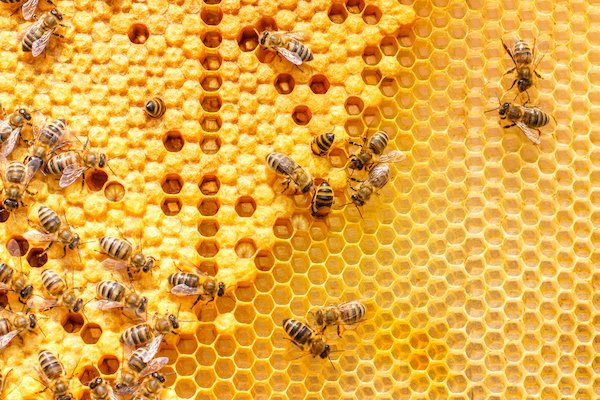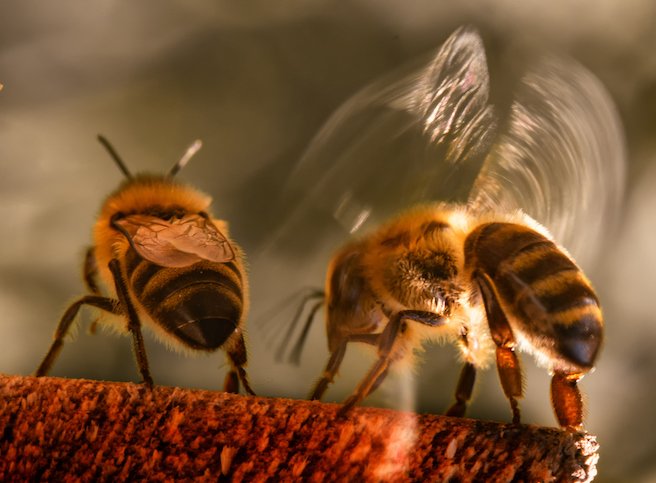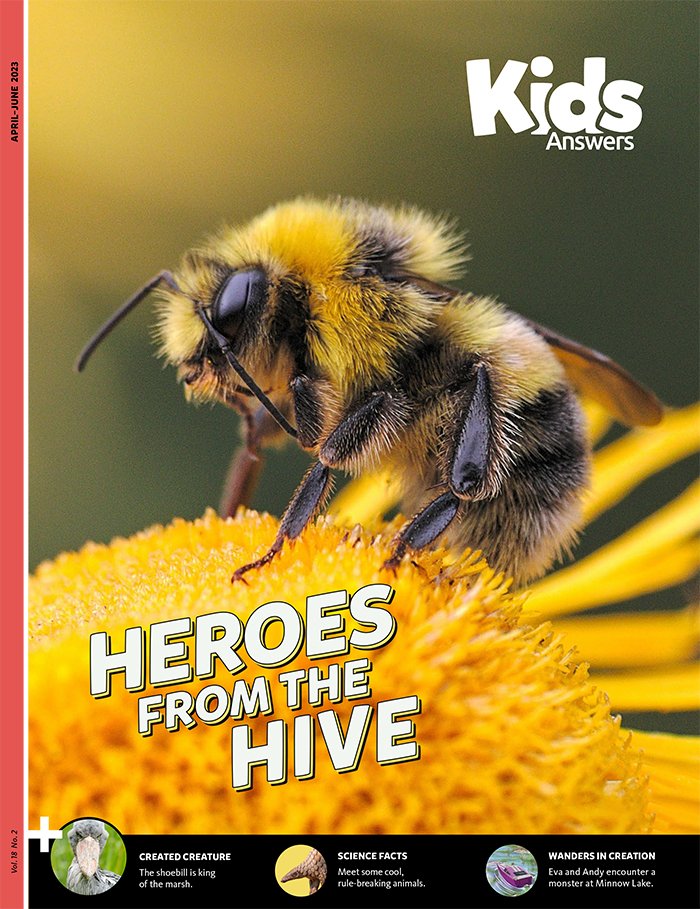Heroes from the Hive
Photo by Dmitry Grigoriev on Unsplash
God made honeybees with sensational superpowers.
by Schuyler Vander Wilt on April 1, 2023You've probably heard a lot about superheroes like Spiderman and Batman. But did you know that God created tiny superheroes in nature? They’re easy to spot in your backyard every summer.

These surprising superheroes wear fuzzy black-and-yellow striped suits. They can fly, have super vision, and help make some of your favorite foods.
If you’re thinking of honeybees, you’re exactly right! God gave honeybees many special superpowers to survive in our fallen world while taking care of plants, animals—and even you.
Super Workers
Honeybees aren’t just superheroes—they’re also super at their day jobs. They collect both pollen and nectar as food. Both bee treats are made inside flowers. Pollen provides healthy fat and protein for the bees’ diet. They collect it to take back to their hives to feed those who don’t work in the flower fields. Nectar provides bees with the sugar rush they need for flight. After bees have their fill of nectar, leftovers are stored in their stomachs until they get back to the hive. They use the rest of the nectar to make their specialty dish—honey.

Anytime honeybees land on a flower, some extra pollen dust sticks to them and stays stuck as they zip to their next flower target. When they land, the pollen rubs off and fertilizes the flower. This is what makes fruits, vegetables, and nuts grow. Some of your favorite foods and drinks, like pickles, jelly, fruit juice, and lemonade, could not be made without help from honeybees. They help make one out of every three bites of food you eat or drink!
Honeybees pollinate 1,000–5,000 flowers every day. They are so important to farmers that truckloads of beehives are shipped to farms around the country to pollinate crops each year. Imagine the buzz you’d hear if you passed a truckful of bees on the road!
Super Suit

Every part of a honeybee’s superhero outfit serves a special purpose—even their stripes. God designed a bee’s black and bright yellow stripes to warn predators, “If you get too close, I’ll sting!”
When you get up close to one of these tiny superheroes, you’ll see that its striped body is also fuzzy. But this fuzz isn’t there to keep the bee warm on chilly mornings. These tiny hairs collect pollen so bees can transport this valuable gold dust from flower to flower.
On both sides of their bodies, bees have two wings that are specialized with flexibility to twist and rotate to help them haul heavy loads of pollen.
The final touch to a honeybee’s super suit is the “basket” attached to each of its back legs. Honeybees fill these baskets with pollen to carry back to their hives.
Superpowers

God equipped honeybees with spectacular superpowers that they use both when they’re on the job and when they need to protect their hives.
Though their brains are tiny—about the size of a grain of rice—honeybees are super smart. They can remember which flowers they’ve already visited. And when nectar is too deep, bees bite a hole in the bottom of the flower to reach their food. Honeybees also have their own language. They communicate by moving their bodies in a figure-eight pattern. This special “waggle” dance tells their colony where food is and when danger is up ahead.
Honeybees have super vision. They have five eyes—three small eyes on the top of their heads and two large eyes on either side. These special eyes allow them to see ultraviolet light that is invisible to the human eye. Their eyes also help them see individual flowers even while briskly buzzing through a field.
Honeybees might be small, but they are mighty. A bee’s fully loaded pollen basket can hold up to one-third of a bee’s body weight, so they need super strength to carry these oversized loads around.
Bees in Battle

Before Adam and Eve sinned, all creatures lived together peacefully. But when sin and death entered the world, plants and animals had to protect themselves. You probably already know that bees sting when they feel threatened. But how do bees go into battle against predators like wasps or hornets who think bees make a tasty meal? God gave bees several creative strategies to protect themselves.
- Poo Paint Some bees decorate the outside of their hives with an extra-smelly paint—animal poo! Scientists found that hornets often avoid harassing hives painted with poo.
- Buzzing Oven A swarm of honeybees form a buzzing ball around an intruding hornet and vibrate their wing muscles to produce heat. When hundreds of bees do this at the same time, the ball of honeybees heats up like an oven and “cooks” the hornet.
- Shimmery Shield By swarming and “doing the wave” outside the hive, bees make their hive appear to shimmer, scaring an intruder away.
Disappearing Act
Sadly, many things are causing the number of honeybees in the world to shrink. These tiny superheroes get sick from things like diseases, pesticides that farmers use to keep pesky bugs off their crops, and parasites like varroa mites, which drink bee blood and infect bees with a virus. Bees can spread sickness by coming close to other bees, but they will usually choose to protect the rest of their colony by leaving the hive when feeling sick. A combination of these factors have led to something called “colony collapse disorder,” when most of the adult bees suddenly abandon their hive.
Next time you’re playing outside, keep an eye—and an ear!—out for these bitty buzzing friends. And when you see them zipping through your yard, stopping on a daisy, or hefting their heavy pollen loads, remember to thank God for creating honeybees—the superheroes with big jobs.
Kids Answers Magazine
Heroes from the Hive
God made honeybees with sensational superpowers.
Browse Kids Issue- © 2024 Answers in Genesis
- Privacy Policy
- Contact
- About

